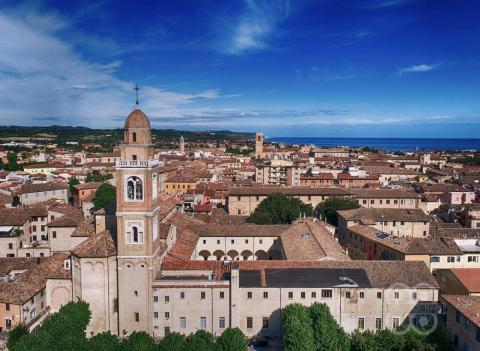Discovering Fano
From the great wealth of the Italian heritage sometimes emerge treasures to be discovered, such as churches, palaces, museums and masterpieces, preserved in smaller towns capable of guarding extraordinary and somewhat secret beauties. The city of Fano is one of these national treasures: a jewel in the heart of the Marche region rich in history and culture that knows how to amaze its visitors.
Among the places to discover in this ancient city, the Fanum Fortunae of Vitruvian memory, there are the suggestive streets of the center and the characteristic alleys of the port, the original fishermen's quarter, the splendid hills along the Metauro valley and the many masterpieces kept in the Pinacoteca del Palazzo Malatestiano Museum, like the admirable altarpiece by Giovanni Santi, Raphael's father.
Fano's destiny has always been linked to the sea, and it is right on the ancient streets of the port that one of the most beautiful districts of the city rises: El Gugul. The district is the symbolic place of the Fano fishermen (called the purtulòt), as well as the most authentic part of the city. The picturesque district, characterized by small fishermen's houses, is dominated by an explosion of bright colors that enrich the facades of the various houses: images and colors linked to history and which reflect the ancient seafaring tradition. Autonomous and independent from the rest of the city, El Gugul is an exciting neighborhood where a proud community with its own dialect and unique cultural tradition still lives. El Gugul takes its name from the cogollo (gugul in the Marche dialect), a fishing net used to trap eels.
Leaving the port behind, we enter the heart of the city to discover the tower houses: homes of noble families and emblems of their power and wealth. These architectures, dating back to the Middle Ages, are scattered throughout the historic centre, protected by the city walls. The "tower houses" are fortified buildings, developed mainly in height, which were used as private homes but which, by virtue of their solid and elevated structure, were used as necessary as military or private defensive structures. The timeless beauty of these buildings still makes them coveted and sought-after homes today.
In the space of the historic center, which preserves the architectural splendor of the past, Fano contains unmissable masterpieces of Italian art. The Pinacoteca del Palazzo Malatestiano preserves important works on a sacred theme such as the Altarpiece Madonna and Child Enthroned with Saints Elena, Zaccaria, Sebastiano and Rocco by Giovanni Santi, the father of the divine Raphael, the Guardian Angel by Guercino, the San Nicholas of Bari brought to glory by the angels of Mattia Preti and the Annunciation of Guido Reni, brought back to its original splendor by the recent restoration. Works that are truly worth the journey of discovery.
A few kilometers from the historic city center, on the splendid hills of Fano, stands in an isolated position, like a real oasis of peace, one of the most evocative buildings in the Marche region: the Hermitage of Monte Giove. The Hermitage is one of the landscape excellences of the area, a real jewel set in the hills that offers a breathtaking view of the Metauro valley. It is said that in ancient times this hermitage was dedicated to Jupiter, but there are no certain testimonies. The architectural complex that can be visited today was built in 1609 by the will of the Camaldolese monks and erected over two hundred meters above sea level, this place of silence and enchantment is good for the eyes and the spirit. The hermitage is completed by a rich library which houses a nucleus of a thousand valuable books dating back to the 16th century.
